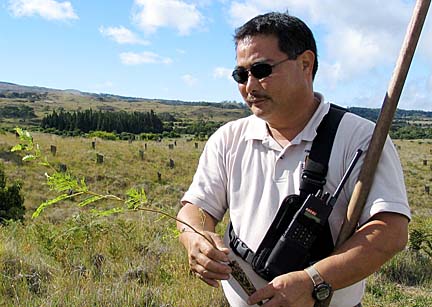
|
Koa forest comeback
relies on volunteers
Efforts on two islands focus on
native birds and timber interests
HAKALAU FOREST NATIONAL WILDLIFE REFUGE, Hawaii » Impenetrable koa forests once shaded the lower southern slopes of Mauna Kea and other sprawling tracts on the Big Island now covered by acres of yellowed grasses.
But Hawaii's largest endemic tree, with its sickle-shaped leaves, has reclaimed some of its former territory over the past two decades.
Conservationists and small timber harvesters have replanted koa on thousands of acres on the Big Island and Maui and have increasingly fenced out the cattle, pigs and goats that forage on koa bark and seedlings.
 They hope replanting the slow-growing trees can help restore the feeding and nesting grounds of endangered native forest birds and quench demand for valuable koa timber, whose scarcity and lustrous grain ranks it among the world's most expensive woods. A tree can take 40 years to mature.
They hope replanting the slow-growing trees can help restore the feeding and nesting grounds of endangered native forest birds and quench demand for valuable koa timber, whose scarcity and lustrous grain ranks it among the world's most expensive woods. A tree can take 40 years to mature.
"Koa is a key species in the ecology of the Hawaiian forests," according to Craig Elevitch, co-author of the book "Growing Koa." "It's also one of the most important trees to human culture and economy in Hawaii."
Koa trees are slowly recovering on the slopes of Mauna Kea at Hakalau Forest National Wildlife Refuge, which was set aside specifically for forest birds.
Since the refuge opened in 1985, volunteers and refuge officials have replanted more than 271,000 koa trees on about 5,000 acres, with survival rates averaging 70 percent, said Baron Horiuchi, a horticulturist for the U.S. Fish and Wildlife Service.
More than half of Hawaii's 31 birds on the federal endangered species list are small forest varieties, according to the Fish and Wildlife Service, which oversees the refuge. Twenty-eight percent of Hawaii's 93 native bird species are already extinct, according to federal figures.
The birds need koa to shelter the smaller plants they feed on, such as the red splayed blossoms of the ohia lehua, giant Hawaiian raspberries and marble-sized red ohelo berries. A spreading koa canopy protects seedlings and smaller plants from cold upland temperatures, which can dip into the 20s during winter on Mauna Kea.
"Koa is a pioneering tree," Horiuchi said. "It leads the way for the rest of the forest."
In many parts of the refuge, koa trees are the only native plants growing among the tall, introduced species of weeds and grass. The branches on many of the larger trees at Hakalau grow in a serpentine network, an illustration of the name for this area, which means "many perches" in Hawaiian.
"The point is not to grow them straight for timber or canoe logs," Horiuchi said. "They are to grow as a canopy and a bird habitat."
Private koa farmers prefer the tall, straight-growing trees. They hope to harvest the semi-hard wood, which ranges in color from blond to red to dark brown, for furniture, bowls, musical instruments and canoes.
Umikoa Ranch on the Big Island, in partnership with state land officials, reforested 800 acres with koa trees between 1980 and 2004.
David Matsuura, managing steward at the 2,000 acre ranch, said some of the trees planted about 15 years ago have already reached large diameters, although he isn't sure about the quality of the wood.
"That's the problem with koa. It's a very long-term crop," Matsuura said. "I'm gonna be pretty old and gray before most of our koa is actually harvested."
Ranch managers said the trees have already helped re-establish native plants and animals, including eight endangered Hawaiian ducks. The return of koa has also increased water sources at Umikoa, where the sickle-shaped koa stems draw fog and moisture into the watershed.
"Our main goal is the integration of conservation and agriculture," Matsuura said. "It's not the same as clear-cutting."
But profit is also a goal for koa farmers, who are gambling over the long term on a product that commands premium prices. At Hawaiian Koa Furniture in Honolulu, a 54-inch round koa table sells for $8,000. A king-sized koa sleigh bed frame sells for $11,560 at Martin & McArthur in Honolulu, and the cost jumps to $16,184 for the model carved from the rare "curly" koa grain.
Riccardo Dellera, a woodworker in Honolulu, used to pay $3 a board foot for koa in the early 1980s; a board foot is one inch thick and one foot square. Today the price is about $30 a board foot.
"I remember someone asking for $12 a board foot and that seemed unbelievable," said Dellera, who owns Dellera's Woodworks in Honolulu. "The cost of koa has just gone up dramatically."
The bulk of the koa market is driven by Hawaii residents, who are the world's biggest consumers of richly varnished koa products.
"Koa is king in Hawaii," Matsuura said. "Only here in Hawaii will people literally pay 10 times the value of anything because it's koa."
E-mail to City Desk
[News] [Business] [Features] [Sports] [Editorial] [Do It Electric!]
[Classified Ads] [Search] [Subscribe] [Info] [Letter to Editor]
[Feedback]
